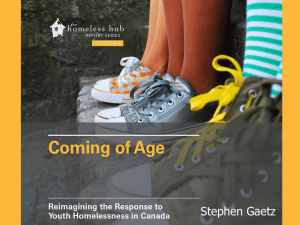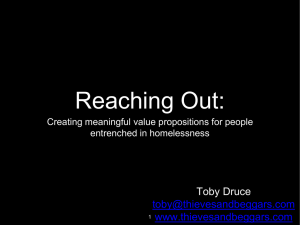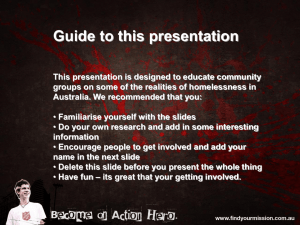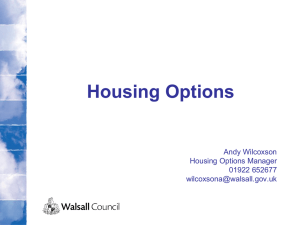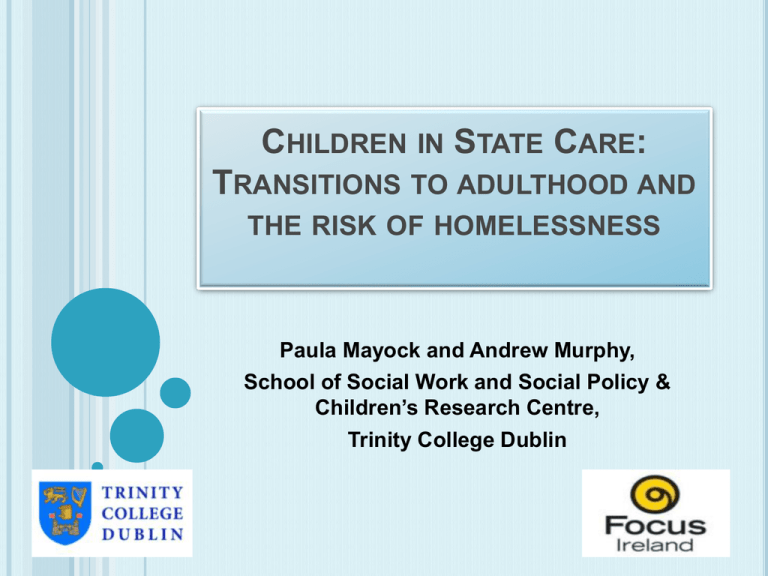
CHILDREN IN STATE CARE:
TRANSITIONS TO ADULTHOOD AND
THE RISK OF HOMELESSNESS
Paula Mayock and Andrew Murphy,
School of Social Work and Social Policy &
Children’s Research Centre,
Trinity College Dublin
ACKNOWLEDGEMENTS
Co-author, Andrew Murphy
Sarah Parker, Research Assisstant to the study
Focus Ireland, funder of the research
Study Participants: young people and family members
Service Providers who assisted with the recruitment
process
CARE LEAVERS AND THE TRANSITION TO
ADULTHOOD: CHALLENGES AND RISKS
The period after leaving care can be problematic for many young
people who, accroding to research evidence, disproportionately
experience:
homelessness;
poor education and employment outcomes;
mental health problems;
early parenting;
contact with the criminal justice system. (Mendes et al., 2011; Stein,
2012).
Heightened vulnerabilities due to:
weak informal support mechanisms and/or to financial help;
lack of formal preparation and supports;
early experiences of separation which can contribute to ongoing
emotional disturbances, developmental delay, and behavioural difficulties
(Stein, 2000, Stein and Munro, 2008).
significant numbers of care leavers also have specific physical and/or
intellectual disabilities (Green and Jones, 1999).
ACCELERATED & COMPRESSED
TRANSITIONS
Transitioning to Independence:
Care leavers experiences contrast with those of
‘mainstream’ youth, who typically:
• Continue to live at home until their early twenties;
• Continue to receive social, practical, emotional and
financial support into early adulthood (Arnett, 2007;
Vassallo et al., 2009).
Several studies have critiqued the narrow linking of supports
for young people to their chronological age rather than need
(Bristow et al., 2012; Cummins et al., 2012; Whyte, 2011).
CATEGORIES OF CARE LEAVERS
Stein (2012) suggests that care leavers tend to fall into 3 main categories:
‘Moving-on group’ – likely to have:
experienced secure and stable placements,
be highly resilient, welcome independence
be able to make effective use of leaving and after-care supports.
‘Survivors’ - may have:
experienced significant instability and discontinuity.
Outcomes tend to reflect the effectiveness of after-care supports provided.
‘Strugglers’ - most likely to have:
had the most negative pre-care experiences,
more likely to experience significant social and emotional deficits.
After-care support is unlikely to alleviate these problems, but is still viewed as important
by them.
Stein argues that three key reforms are required to improve outcomes for care
leavers:
improving the quality of care, as positive in-care experiences are essential for overcoming
damaging pre-care experiences of abuse or neglect;
ensuring a more gradual and flexible transition from care;
and providing more specialised after-care supports.
THE LINK BETWEEN HISTOIES OF STATE CARE
AND HOMELESSNESS: THE RESEARCH EVICENCE
Several Irish studies have identified state care as a risk factor for
homelessness:
Keane & Crowley’s (1990) study of youth homelessness in Limerick found
that 29% of those young people who were out-of-home had previously
been in care.
Kelleher et al.(2000) found that 33% of those leaving health board care
had experienced homelessness within six months, rising to 66% within two
years.
Pillinger, J. (2005; 2007) research highlights the risk of homelessness for
those who have been in care as children, and for young people when
leaving the care system.
6-year Longitudinal Study, Dublin-based (Mayock & O’Sullivan, 2007;
Mayock et al., 2008; Mayock & Corr, 2013).
Cross-sectional Study, Cork-based (Mayock & Carr, 2008).
Biographical Study of Homeless Women in Ireland (Mayock &
Sheridan, 2012).
THE FOCUS OF THE PAPER
Clearly, not all young people with histories of State Care go on
to experience homelessness or housing instability.
While the association between histories of State Care the risk of
homelessness is widely recognised, there is relative dearth of
dedicated research attention to the kinds of care experiences
that make young people vulnerable to homelessness or housing
stability subsequent to leaving care.
This paper will examine the care experiences of those homeless
young people in a recently conducted study who were
categoriesd as taking a care pathway to homelessness,
including:
Their entry to care
Care disruptions and breakdowns
Aftercare support
BACKGROUND TO THE STUDY
o
The available evidence indicates that youth homelessness
remains a significant issue in Ireland and throughout
Europe.
o
This research aimed to build upon and extend earlier studies
of youth homelessness in Ireland (Mayock & Vekic, 2006;
Mayock et al., 2008; Mayock & Corr, 2013) and to advance
knowledge and understanding of the processes associated
with young people becoming and/or remaining homeless,
particularly in light of Ireland’s changing economic
landscape.
o
The study makes an innovative departure from existing
research on homeless youth in Ireland by extending its
scope to include the perspectives of the families of a subsample of the participants.
RESEARCH AIMS AND OBJECTIVES
Overall Aim: This research set out to generate in-depth
knowledge and enhance understanding of the dynamics of
youth homelessness and the life experiences of homeless or
‘out of home’ young people and their families in Ireland.
More specifically, the study’s objectives were to:
•
•
•
•
Identify young people’s routes or paths ‘out of home’;
Examine their experiences (of accommodation,
education/training, daily life, and so on) after leaving home;
Track young people’s interactions with services and
systems of intervention over time; and
Identify facilitators and barriers to housing stability.
RESEARCH METHODOLOGY
Data Collection
1) Young people (n = 40): Life History Interviews/Biographical
Approach
• ‘Open invitation; allows young people to take control of the
interview.
• Allowed young people to articulate their views and to elaborate
on ‘critical moments’, transition, and change in their lives.
2) Family Members (n = 10): Qualitative In-depth Interviews
• Detailed, yet informal orientation – good for researching
sensitive topics.
• Acted as a ‘conversation with a purpose’.
The data collection phase of the research was conducted over an
eight-month period between May 2013 and January 2014.
CARE PATHWAYS TO HOMELESSNESS
26 of the 40 young people (65%) reported a history of state care.
Of these, 14 (9 males and 5 females) were identified as having taken a
care history pathway to homelessness.
Those young people categorised as taking a care history pathwaywere
distinctive in terms of:
the length of time in care - all had spent 3 or more consecutive
years in a care setting(s);
the impact that the care experience had on their lives;
family reunification was rare (when they were (n=2) the young
person entered emergency homeless services soon after); and
they left a care setting and entered homeless/youth crisis
accommodation.
LIVING CIRCUMSTANCES AT TIME OF
INTERVIEW
Accommodation Type
Care Pathway (n = 14)
Under 18s ‘Out of Home’ Provision
2
Temporary Emergency
Accommodation (TEA) (ages 18-23
years)
1
Supported Temporary
Accommodation (STA) (ages 18 –
25/26 years)
5
Semi-independent Accommodation
Residential After-Care
1
2
Adult Supported Temporary
Accommodation (STA)
Adult Emergency Hostel (on a night
by night basis)
Private Rental Accommodation
1
1
1
ENTRY TO CARE
Many of the young people in the care pathway category reported:
high levels of anxiety at the point of their entry to care;
a lack of understanding about the reasons for their plaement in care;
conflicting emotions towards their parents and families;
dissatisfaction with professionals involved in removing them from
home;
poor information and communication during the early phase of care.
“They (social workers) didn’t explain it properly like, you know. I was told
things like but, I was told by my foster parents that my mother and father
were never, I was never going to see them again and that they didn’t want
me, you know, all that stuff.” (Sam, 19, entered care age 2).
“I remember the social worker was saying, like, ‘Are you coming with me?’.
And I was like, ‘Where are we going?’ You’re going on a really long holiday.
I suppose I thought I was on a holiday for a while. And then just it never
ended really so, I just kind of got used to, you know. They said I’m fostered,
you’re living here, that was it.” (Christopher, 16, entered care age 4).
CARE DISRUPTIONS AND BREAKDOWNS
11/14:
3/14:
9/14:
had been in foster care.
had been in residential care only.
had experienced a residential care setting (these residential
care settings were often accessed through the Crisis
Intervention Service).
Several young people had experienced unplanned and sudden
terminations of foster or other care placements:
11/14 – had experienced at least two or more placements.
8/11 – had experienced five or more care/crisis placements.
1/14 – had experienced a long-term uninterrupted placement in a foster
care setting (entered homeless services when this placements broke
down as a young adult).
3/14 – had experienced long term foster care placements lasting over 3
years (all three entered emergency homeless accommodation when
these placements broke down).
2/14 – had experienced one residential placement only.
1 /14 – had spent time in a Children’s Detention Centre.
CARE DISRUPTIONS AND BREAKDOWNS
“(Social Worker) just came and said it, they never gave me a reason why I was
getting moved out of all these places. I was never any trouble to any of them. It
was just literally turn up at the door and ‘Oh yeah, then you’re going’...I was in
five or six foster homes...in foster care like I was just fucked around...just
fucking throw her around and it’s nothing to her, it’s like you have no feelings. I
was kind of looking at them saying ‘Do you think I have no feelings that you can
just fuck me around like that?’” (Aoife, 19, entered care age 10).
“Well I was in foster care all my life, well until I was about thirteen I was in about
twenty or thirty different houses... and since I was about five or six I was in
about ten or eleven different primary schools. It’s hard enough to get used to,
moving around, I got moved three and four times a year” (Sam, 19, entered
care age 2).
Almost all of the young people in this pathway had a childhood characterised
by transience. For many, this pattern has continued into adulthood:
“I’m not used to being settled, you know, if I stay settled in somewhere I
actually start to feel like oh I better leave, you know, I’m still not used to staying
somewhere that it’s, it’s uncomfortable and when I do get settled I’m like oh my
god, I need to move, I’m not liking it anymore” (Chloe, 22, entered care age 12).
EDUCATIONAL EXPERIENCES
Several young people reported periods of suspension and exclusion from school, or left
school at an early age and before completing their formal education.
4/14 completed the Leaving Certificate.
6/14 had been excluded from school due to challenging behaviours
2/14 currently attending school.
Several struggled to continue education becaue of the instability of their living situation which
was often associated with placement breakdown.
“I enjoyed school, was good at school, just I couldn’t concentrate as I had to move to different
places with care.” (Raphael, 22)
This was often exacerbated by school avoidance and non-attendance while in care settings.
Several of the participants are now attempting to address their education needs as young
adults.
“Yeah, like my past is effecting because any jobs I apply for I never really get because I have to
kind of educate myself because I left school when I was 13 like. I never done my junior cert or
my leaving cert or anything but intellectually I’m smart like.” (Eric, 21)
MENTAL HEALTH ISSUES
11/14 reported challenges to their psychological stability:
issues such as bipolar disorder, schizophrenia, severe episodes of anxiety and
depression that required ongoing psychiatric intervention and monitoring.
3/14 participants reported diagnosis of Attention Deficit Hyperactivity Disorder (ADHD).
Several expressed suicidal thoughts.
A smaller number had attempted suicide.
Some of the most severely affected in terms of placement stability (both in childhood and as
adults) were those with ADHD and enduring mental health issues such bipolar disorder and
schizophrenia.
Placement transitions and accommodation breakdowns were significant in terms of their
ability to manage their mental health.
Some of the young people attributed improvements in their mental health to the stability and
support provided through residential care and supported accommodation settings.
“Going into care (residential) was the best decision that ever happened to me. Well because if I didn’t go into care, I probably
wouldn’t still be here anyway with the depression and all you know?” (Abigail, 19)
“I just turned me phone off and like after that like after a few weeks I just got more and more depressed I was just thinkin’ of
suicide ways then, just thinkin’ of ways to kill meself then and then when I moved I here I knew I had to get help then”
(Patrick, 19).
LEAVING CARE: A CRISIS POINT
Many of the young people left care settings in crisis and at a point when they were
extremely vulnerable.
Issues related to mental health, challenging behaviour and substance use were
implicated in the termination of several placements in both foster and residential care
settings.
“Not long before I turned seventeen I started smoking heroin. So then after
about four weeks I was addicted to it and then I woke up one morning and I
was told I had to leave (residential care) and I suppose I've been homeless
since, since I was seventeen really, you know... now I’d love to go back, you
know. And not fuck up and make all the mistakes I did because if I hadn’t of
went near the gear (heroin), you know, they would have helped me get a
proper place.” (Craig, 22, entered care age 14).
“I (attempted suicide) and I was in hospital for five months and then I got put
into a residential unit for two weeks but then I got kicked out of there
because I was being abusive to the staff. I was only after turning 18 two days
and that’s when they kicked me out.” (Aoife, 19, entered care age 10).
THE TRANSITION TO ADULT SERVICES
Others highlighted the difficulties they experienced at the point of
leaving care when they transitioned to adult services:
“Yeah I loved it I did (residential care setting), fucked my life
when it was up, because then to over 18s (services) ...Then I
had to start staying in hostels. Hitting drugs like, do you know
what I mean in (adult emergency hostel). Yeah, I got strung out
in there” (Warren, 23, entered care age 11).
“I mean the difference from before I turned 18 and when I turned
18 I mean it was like, you know I had my social worker and key
worker and the staff in the hostel and then that all went away.
There was no support there. And nobody prepares you for that.
Like everyone says oh you turn 18, you are a statistic then you
know what I mean. You know what’s going to happen but you
don’t realise its such a change from all the support you get”
(Maria, 23, entered care age 13).
AFTERCARE
Only 4 of the 14 young people was allocated an aftercare
worker, either prior to or at the point of leaving care.
Two of these young people were living in a residential
aftercare setting and two were receiving aftercare outreach
support.
Those who received aftercare support tended to have lived
in residential care settings prior to reaching the age of 18
years.
Those who received aftercare support were generally
positive about the service and highlighted:
Their relationship with individual workers;
Access to ongoing advice, guidance and information ;
Practical support and preparation skills for independent living
AFTERCARE
“I have fights with her(aftercare worker), but she is really nice, she
helps me with everything like with my appointments or like if you
had to get your medical card. She’d follow up on like have you got
your birth cert, like everything, your labour, a place to stay and just
like kind of with your life in general like.” (Aoife, 19)
“But it’s good here (residential aftercare), like you have a lot of
independence here as opposed to being in residential care.
(Aftercare worker) helps me with like college stuff, and like if I have
to fill in grants, or like do you know if I need to get something from
somewhere else” (Abigail, 19)
“Yeah, they (residential aftercare) were okay, they used to come,
come give you, give me some clothing grants and preparing to
move on, like to move me on to independent living. So that’s why
my independent living skills was, was kind of started at (residential
aftercare).” (Raphael, 22)
FAMILY RELATIONSHIPS & CONTACT
Contact with and availability of support from family members, tended to be
weaker with in this subgroup.
Contact largely consisted of irregular home visits, telephone calls and social
media contacts.
Several young people had no contact with parents, estrangement and family
discord was frequently reported:
“I don’t speak to my parents so I don’t see her (sister) and I don’t see my
other little brother because of that reason as well” (Chloe, 22)
“Like none of my family would even offer you to stay in their houses or
anything even though they know that you are walking the streets all
night...but not one of my aunties or uncles would offer you to come out and
say ‘Come on out and sit out here for the day.’ They are just, I wouldn’t even
call them family.” (Aoife, 19)
“I wouldn’t want to go back to me Mums you know. She’s in treatment and
dealing with her own stuff, you know. She’s married to a new guy as well and,
you know, so it’s just like we don’t even really talk or anything so, there’d be
no point.” (Craig, 22)
IDENTITY AND BELONGING
Many of the young people in the care pathway described feelings abandoned and had fractured
sense of belonging.
They had typically experienced multiple losses:
their home
contact with siblings
school
circle of friends
extended family and community.
“I feel like I missed out on a family and that like, I feel like I don’t know them, I missed them
growing up ... because I see where they (family members) all get on with everyone else you
know what I mean, I didn’t get the chance of that at all. I would have liked that you know, to
feel like I belonged somewhere like.” (Sam, 19, entered care age 2).
“Those kinds of things like, they really affect you like when you don’t feel someone loves
you literally like go out craving and looking for that love and that attention that you’re
missing so definitely like feeling unwanted constantly like, definitely had a serious effect on
me like.” (Chloe, 22, entered care age 12).
“But I don’t know I used to be ashamed before because people knew I was fostered and
they used to say to me at school and all. So I went down as like my foster name, my
surname in school and all that like.” (Gareth, 24, entered care as young infant).
CONCLUDING REMARKS
There is nothing inevitable care leavers doing less well. However:
Overlapping adversities and the experience of care can negatively impact on the life
chances of young people leaving care;
Poor and multiple care experiences appears to increase the risk of ‘drift’ within homeless
service systems and for repeat or prolonged homelessness;
Patterns of particular disadvantage experienced by looked after children require specific
and targeted intervention (mental health, family supports, education needs).
Data concerning these young people - including their pre-care experiences, care
experiences and post-care trajectories, is necessary for the development of effective
preventative and support measures.
Findings in the current study are consistent with previous research which
emphasis that the transition from care needs to be:
More normative and less accelerated.
Care leavers should be assisted according to their developmental needs, rather than
chronological age.
Post-care supports should be mandatory, not discretionary.
Increased capacity and enhanced consistency is necessary if leaving care programmes
are to deliver genuine outcomes to this group.
REFERENCES
Arnett, J. J. (2007). Adolescence and emerging adulthood: A cultural approach, 3rd Ed. Upper Saddle River, NJ: Pearson-Prentice Hall
Bebbington, A. and Miles, J. (1989) ‘The background of children who enter local authority care’, British Journal of Social Work, 19, pp. 349–68.
Bristow G, Cameron L, Marshall K, Omerogullari S. 2012. Continuing care: A new approach and practice implications for supporting young people exiting
care. Developing Practice 33: 105–110.
Cummins P, Scott D, Scales B. 2012. Report of the Protecting Victoria’s Vulnerable Children Inquiry. Victorian Government: Melbourne, Australia.
Dickens, J., Howell, D., Thoburn, J. and Schofield, G. (2007) ‘Children starting to be looked after by local authorities in England: An analysis of interauthority variation and case-centred decision making’, British Journal of Social Work, 37(4), pp. 597–617.
Green S, Jones A. 1999. Improving Outcomes for Young People Leaving Care in Victoria. Children’s Welfare Association of Victoria: Melbourne.
Keane, C. & Crowley, G. (1990) On My Own: Report on Youth Homelessness in Limerick City. Limerick: Mid-Western Health Board and Limerick Social
Service Centre.
Kelleher, P., Kelleher, C. and Corbett, M. (2000) Left Out on their Own: Young people leaving care in Ireland. Dublin: Focus Ireland.
Mayock, P. & Carr, N. (2008) Not Just Homelessness … A Study of ‘Out of Home’ Young People in Cork City. Cork: Health Service Executive, South.
Mayock, P. & Vejic, K., (2006)Understanding Youth Homelessness - Key Findings from the First Phase of a LongitudinalCohort Study. Dublin, Children’s
Research Centre and Office for the Minister of Children.
Mayock, P. and O’Sullivan, E. (2007) Lives in Crisis: Homeless Young People in Dublin City. Dublin: The Liffey Press.
Mendes, P., Johnson, G., & Moslehuddin, B. (2011). Young people leaving state out-of-home care: a research-based study of Australian policy and
practice. Melbourne: Australian Scholarly Publishing Press.
Oliver, C., Owen, C., Statham, J. and Moss, P. (2001) Facts and Figures: Local Authority Variance on Indicators Concerning Child Protection and Children
Looked After, London, Thomas Coram Research Unit.
Pillinger, J. (2005): Preventing Homelessness: A Comprehensive Strategy to Prevent Homelessness in Dublin, 2005–2010. Dublin: Homeless Agency
Pillinger, J. (2007): Homeless Pathways: developing effective strategies to address pathways into, through and out of homelessness. Dublin: Focus Ireland
Stein M. 2000. Leaving care. In The Blackwell Encyclopedia of Social Work, Davies M (ed.). Blackwell: Oxford; 192–193.
Stein, M. (2012) Young People Leaving Care: Supporting pathways to adulthood, Jessica Kingsley, London
Stein, M. and Munro, E.R. (eds) (2008) Young People's Transitions from Care to Adulthood: International Research and Practice. London: Jessica
Kingsley Publishers
Vassallo S, Smart D, Price-Robertson R. 2009. The roles that parents play in the lives of their young adult children. Family Matters 82: 8–14.
Whyte I. 2011. Just Beginnings: The report of Berry Street’s Leaving Care Scoping Project. Berry Street: Melbourne, Australia.





